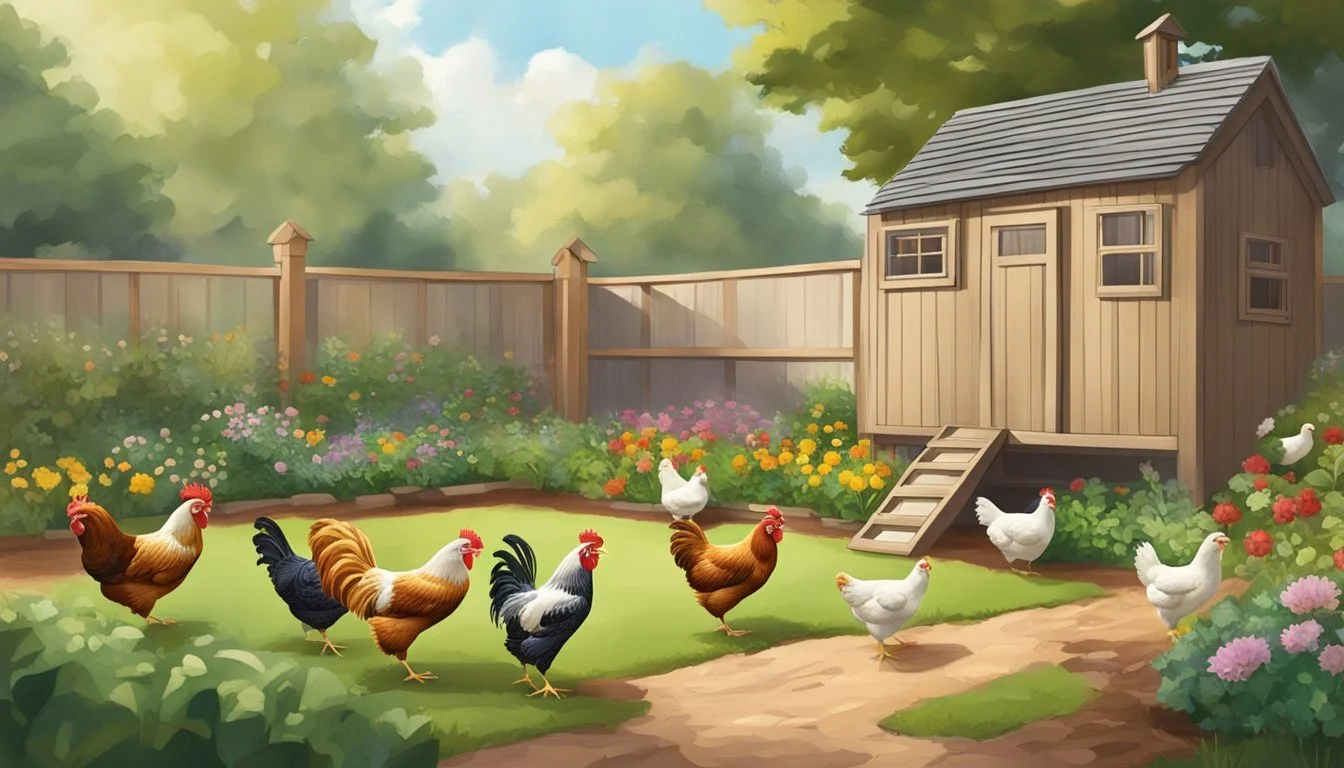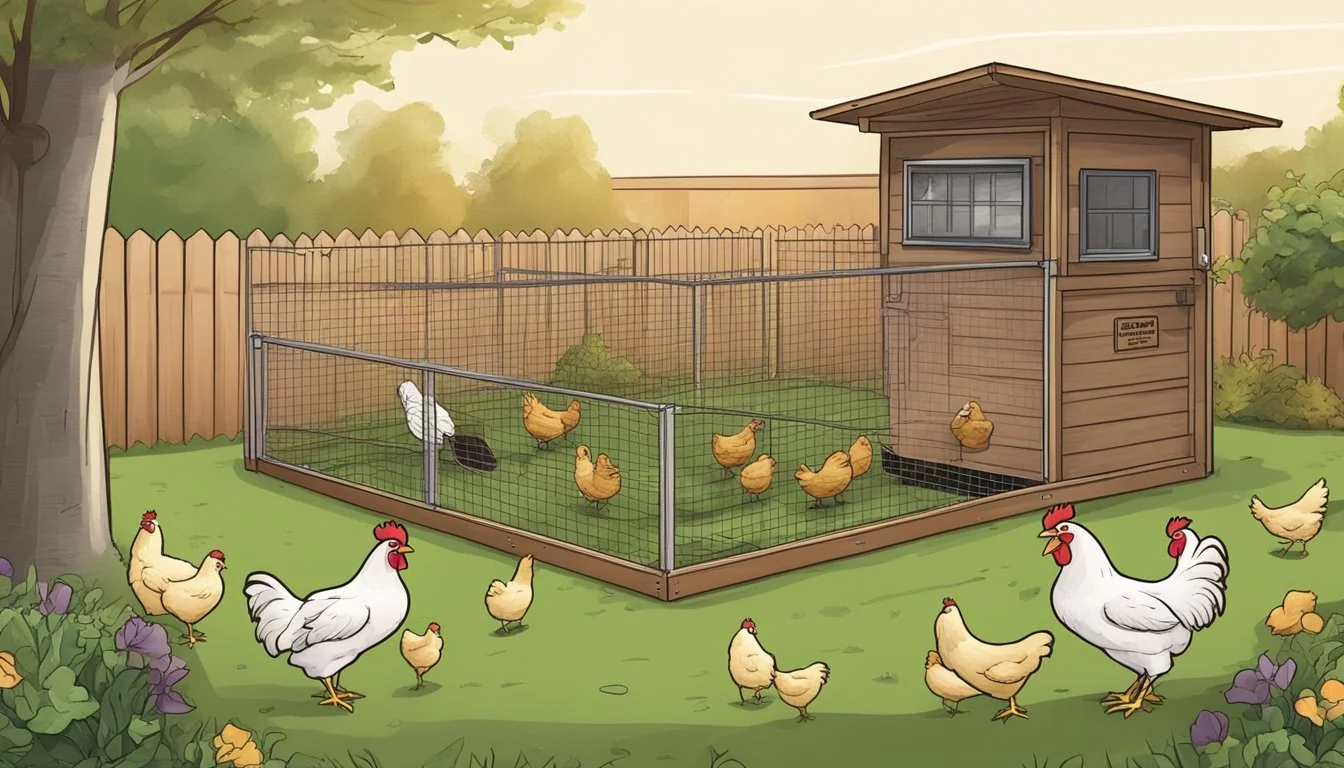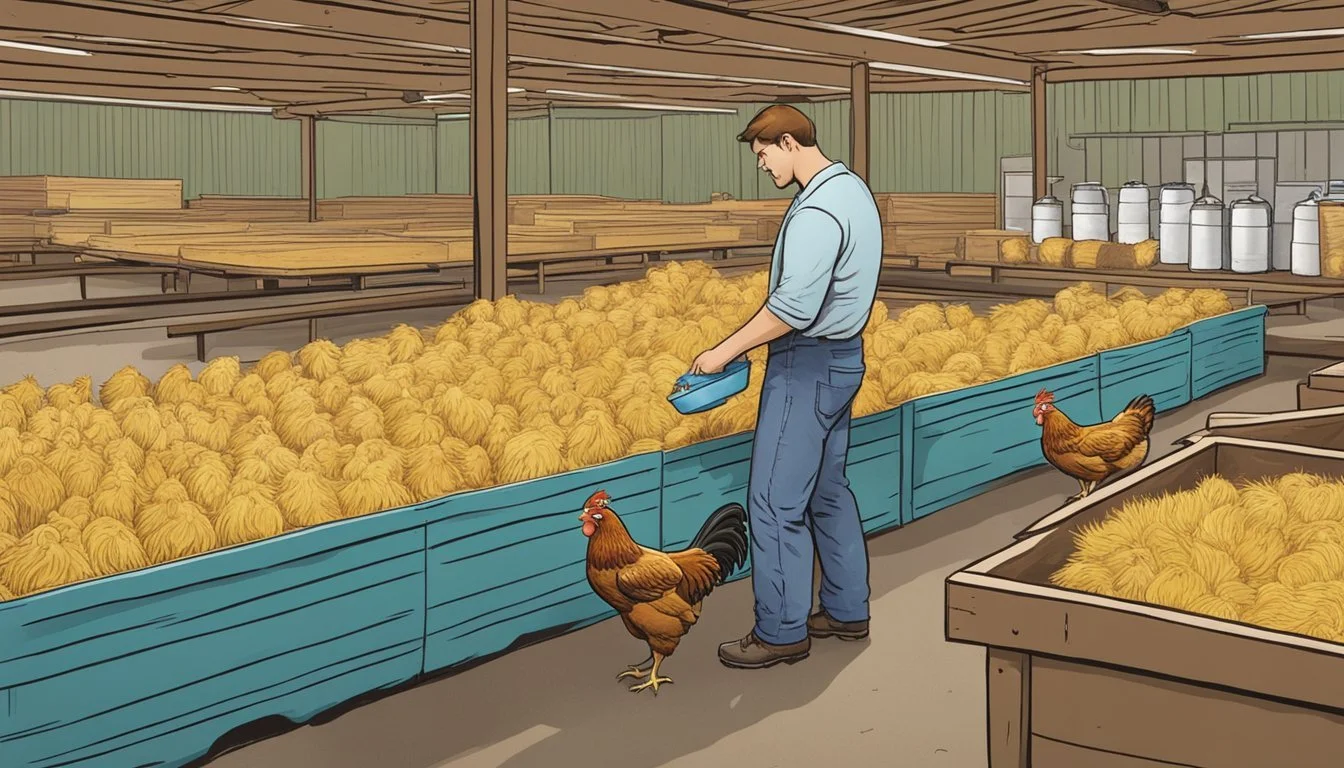Raising Backyard Chickens in Sioux City, IA
Your Essential Guide to Urban Poultry
In Sioux City, Iowa, the practice of raising backyard chickens is becoming an attractive option for residents looking to have a more sustainable lifestyle and access to fresh eggs. The city allows up to four backyard chickens per household, though roosters are banned to avoid noise complaints. To ensure compliance with local ordinances, residents must obtain a permit before establishing a flock.
The pursuit of backyard chicken keeping aligns with a growing movement of urban agriculture and self-sufficiency. In Sioux City, it entails a commitment to understanding and adhering to specific guidelines that regulate the distance of coops from neighboring homes and limit the chickens to certain areas to maintain community standards. These rules aim to balance the benefits of raising chickens with maintaining the quality of life within the community.
Those interested in this endeavor need to be well-informed about both the city's regulations and the responsibilities that come with poultry care. This includes constructing predator-proof coops, maintaining cleanliness to prevent odors and pests, and ensuring the birds are healthy. Sioux City's approach to backyard chickens is part of a broader effort to accommodate residents' interest in local food sources while preserving the residential nature of the city.
Understanding Local Chicken Ordinances
When considering raising backyard chickens in Sioux City, IA, it’s essential to understand the local ordinances that govern the practice. Knowledge of Sioux City zoning and permit requirements, as well as regulations beyond the city limits, are key to lawful urban chicken farming.
Sioux City Zoning and Permits
In Sioux City, residents must obtain a permit to legally keep chickens. This permit requires adherence to specific city ordinances that address the care and keeping of poultry. Key regulations include:
Housing: Chickens must be kept in a proper coop.
Location: Coops must be placed at least 25 feet away from neighboring residences and cannot be positioned in front yards.
Number: There may be a limitation on the number of chickens allowed.
Residents should also consult their Homeowners’ Association (HOA) since HOA guidelines can override or add to city rules.
Regulations Beyond City Limits
Outside of Sioux City, laws regarding backyard chickens vary significantly across different jurisdictions within Iowa.
Windsor Heights, IA: Only two chickens are allowed and must be housed in a coop.
Waukee, IA: Poultry is not permitted within city limits unless on tracts of one acre or more in specific zoning districts.
Cedar Rapids, IA: Regulations exist but vary; direct inquiry to the city is advised.
Des Moines and West Des Moines, IA: Within these cities, there are their own distinctive ordinances and permitting processes regarding chicken keeping.
It is crucial for potential chicken owners to check with local city councils or municipal code websites to ensure compliance with the latest regulations, as these can and do change. Compliance is not only a legal responsibility but also a neighborly consideration.
Selecting the Right Chicken Breed
Choosing the right chicken breed for your backyard in Sioux City requires consideration of your goals, be it egg-laying or meat production, and the ability of the breeds to adapt to Iowa's climate.
Egg-laying vs. Meat Breeds
Egg-laying Chickens:
Leghorn: Known for their prolific egg production, Leghorns can lay about 280-320 white eggs per year.
Rhode Island Red: These are dual-purpose birds that are well-regarded for their brown egg-laying ability as well as their meat.
Lohmann Brown: Commercially favored for egg production, they can lay over 300 brown eggs annually.
Meat Breeds:
Broilers: Generally, broiler chickens are raised specifically for meat production and reach market weight quickly.
Cornish Cross: This breed is commonly used in meat production due to its rapid growth and substantial size.
Adaptability to Iowa Climate
Iowa experiences cold winters and fairly hot summers, so breeds that can handle temperature variations are essential.
Sussex and Araucana chickens have good cold tolerance and are less prone to frostbite.
Cochins have thick feathering that aids in temperature regulation during cold weather.
For summer heat, breeds like the Leghorn are preferable as they are more heat-resistant.
Care must be taken in providing adequate shelter, with heat lamps potentially necessary in winter months for less cold-hardy breeds. Coops must be designed for easy cleaning and be well-ventilated, yet capable of retaining warmth when required.
Designing a Chicken Coop
When constructing a chicken coop in Sioux City, IA, it's essential to focus on two main aspects: size and security for overall coop integrity, and features that provide comfort and nesting for the chickens.
Coop Size and Security
The coop must offer adequate space for chickens to thrive. The recommended floor space is at least 3 square feet per chicken inside the coop and a minimum of 10 square feet per chicken in the outdoor run. Sioux City regulations also require that coops be situated at least 125 feet away from neighbors' residences for optimal placement.
Security is paramount for protecting chickens from predators. A predator-proof coop is non-negotiable, involving durable materials that resist gnawing or tearing. All openings should be covered with hardware cloth, not just chicken wire, which can be easily compromised.
Feature Minimum Requirement Additional Notes Interior Space 3 sq ft per chicken Ensure space for movement Exterior Run Space 10 sq ft per chicken Must be secure and spacious Coop Placement 125 ft from residences Comply with local laws Predatory Defense Hardware cloth on openings Protect against various predators
Nesting and Comfort Features
Chickens need nesting boxes to lay their eggs; typically, one box for every three to four hens suffices. Place these boxes in a darkened area of the coop to provide a sense of security and privacy. Provide soft bedding, such as straw or wood shavings, which needs to be changed regularly to maintain cleanliness.
Proper ventilation is crucial in a chicken coop to keep the air fresh and reduce moisture levels, which can lead to respiratory issues and promote the growth of bacteria and parasites. However, avoid creating drafts in the area where chickens roost.
Lighting plays a crucial role in egg production, especially in the winter months when daylight is scarce. Coop lighting should mimic natural daylight patterns and can be achieved with a timer-controlled light source. Do not, however, compromise the chickens' natural rest by leaving lights on overnight.
Comfort Feature Consideration Nesting Boxes 1 box per 3-4 hens, located in a dark area Bedding Material Soft, absorbent, and needs regular replacement Ventilation Sufficient without causing drafts Light Natural pattern mimicking, with timers if necessary
Constructing a coop with the right dimensions and features not only adheres to local regulations but also ensures a safe, comfortable home for backyard chickens to live and lay eggs.
Feeding and Caring for Chickens
In Sioux City, IA, raising backyard chickens requires diligent feeding and healthcare to ensure the flock's well-being.
Feeding Requirements and Nutrition
Chickens require a balanced diet to thrive. Baby chicks need a starter feed rich in protein to jumpstart their growth. Starter feed typically contains about 20-24% protein. As chickens mature, their dietary needs change, and they should be transitioned to layer feed, containing 16-18% protein, essential for egg production.
Provision of clean, fresh water is crucial, and waterers should be checked daily to avoid contaminants. To deter disease, keep feeders clean and remove any wet or moldy feed promptly.
Maintaining Health and Wellness
Health monitoring is central to backyard chicken care. Watch for signs of disease, such as changes in behavior or appearance. Promptly isolate any sick chickens to protect the rest of the flock.
Common chicken ailments include worms, coccidiosis, and salmonella. Regular deworming and vaccination can prevent these diseases. Additionally, maintain a clean coop to lower disease risk.
To deter feather pecking, which can lead to injury or disease, consider the use of anti-pecking spray and provide ample space for your chickens to roam. Regular inspection and care can create a healthy environment for your chickens to flourish.
Protecting Chickens from Predators
Raising chickens in Sioux City requires vigilance against predators which include both wildlife and rodents. Ensuring the safety of the flock involves both robust coop security measures and an understanding of the local threats that require regular coop inspections.
Enhancing Coop Safety
Build with Strong Materials: Use 1/2 inch hardware cloth for covering windows and vents in chicken coops. It offers higher durability and protection than regular chicken wire, which rodents can gnaw through and predators can tear apart.
Secure the Perimeter: Consider burying the wire at least 12 inches deep around the coop to deter digging predators, and extend it outward to create a skirt that discourages burrowing.
Automatic Coop Doors: Install doors that close automatically at dusk and open at dawn to prevent nocturnal predators from gaining access during vulnerable times.
Regular Inspections: Perform daily inspections of the coop's structural integrity, checking for signs of attempted entry or wear that could be exploited by predators.
Understanding Local Wildlife Threats
Identify Predators: Common predators in the Sioux City area include raccoons, foxes, hawks, and owls. Recognize signs of their presence, like tracks or attempted entry marks on the coop.
Rodent Control: Rodents can be both a nuisance and a threat, attracting larger predators. Keep feed in secure containers and maintain a clean coop to minimize rodent attraction.
Strategic Coop Placement: Place coops at least 125 feet away from living spaces to comply with local regulations, while also considering visibility to deter wildlife from entering the area.
By enacting these specific predator-proof and security measures, chicken keepers in Sioux City can create a safer environment for their backyard flocks.
Community Interaction and Legal Compliance
Raising backyard chickens in Sioux City, IA, involves understanding and adhering to specific legal requirements, and maintaining harmonious relationships with the community. Residents must navigate local ordinances, secure permits, and consider community dynamics related to noise and coop placement.
Navigating Neighborhood Dynamics
Residents interested in raising chickens must consider their neighbors to ensure community harmony. Noise is a common concern; therefore, roosters, known for their loud crowing, are usually not permitted in urban settings. Coop placement is also crucial; coops should be positioned to minimize any disruption to neighbors and must adhere to setback requirements, such as being at least 125 feet away from neighboring residences.
Handling Inspections and Changes in Law
Compliance with city laws and ordinances is mandatory for backyard chicken enthusiasts. Permits may be required, and owners should anticipate periodic inspections to ensure coops are well-ventilated, predator-resistant, and designed for easy cleaning. Furthermore, residents must stay informed about changes in local laws to remain compliant. Changes could affect the number of chickens allowed, housing conditions, and even the sale of eggs or poultry.
Managing Byproducts and Waste
Proper management of chicken byproducts and waste is crucial for maintaining sanitary conditions in backyard poultry environments. This involves not only repurposing manure as a resource but also mitigating health risks by controlling odor and ensuring waste is disposed of properly.
Using Manure as Fertilizer
Chicken manure is an excellent source of nitrogen, phosphorus, and potassium, making it a valuable bio-fertilizer for gardens. Homeowners should compost manure before use, which involves a process of aerobic decomposition that requires balancing carbon-rich materials, like straw or leaves, with the nitrogen in manure. This not only reduces pathogens but also controls smell. Composted manure should be:
Aged: at least 45-60 days before application to crops.
Turned regularly: to ensure even decomposition and aeration.
Controlling Odor and Waste Disposal
To maintain sanitary conditions and reduce health risks:
Clean coops regularly: to prevent buildup of waste and odor.
Implement manure handling systems such as:
Frequent collection and secure storage.
Composting bins designed to contain and break down manure.
Consider using coop deodorizers to neutralize odors, ensuring they are non-toxic to chickens.
Dispose of excess waste by:
Contacting local waste management services for guidelines.
Ensuring that disposal methods adhere to city regulations to prevent attracting pests or causing environmental damage.
Advanced Chicken Care Techniques
Raising chickens in Sioux City, IA, takes dedication and a willingness to employ advanced techniques for enhancing their welfare and productivity. Growing technologies and methods offer significant benefits to both the chickens and their caretakers.
Automating Your Chicken Coop
Automating your chicken coop introduces efficiency and safety while managing your flock. Automatic coop doors not only secure chickens at night but also free caretakers from the strict routine of opening and closing the coop. Coop cameras can be integrated, allowing remote surveillance to ensure the health and safety of the flock without constant physical presence. Coop lighting can be automated to provide optimal light cycles, vital for maintaining consistent egg production among laying hens.
Enhancements for Chicken Productivity
Proper engagement and environmental enrichment are crucial. Offering a variety of toys for chickens can prevent pecking and aggressive behavior, stemming from boredom or stress. This can involve introducing objects that move or dispense treats to encourage natural behaviors, such as foraging and pecking.
Enhancement Benefits Perches Reduces stress, encourages exercise Pecking Toys Promotes foraging, decreases aggression Treat Dispensers Stimulates mental alertness, reduces boredom
Processing Chickens for Meat
For those who raise chickens for meat, understanding the process of slaughtering is essential. It involves several stages: the humane dispatching of the bird, defeathering which can be aided by using a chicken plucker, and evisceration. It's important to follow local regulations regarding the slaughtering of chickens to ensure food safety and animal welfare standards are met. Care must be taken to minimize stress for the bird throughout this process.
Buying and Starting with Chickens
Raising chickens in Sioux City begins with acquiring the right chicks and providing them with the care they need to thrive as they grow. It's essential for potential chicken owners to understand the necessary steps for a healthy start.
Choosing Hatcheries or Farm Stores
Individuals looking to purchase baby chicks can opt for local farm stores or certified hatcheries. Farm stores usually offer a variety of breeds and the convenience of local support, while hatcheries may provide a wider selection of chickens and the assurance of a health guarantee. Regardless of choice, ensuring that the source is reputable guarantees healthy chicks and adherence to local regulations.
Caring for New Chicks
Upon bringing baby chicks home, they require a warm, safe environment and proper nutrition. Starter feed is an essential initial diet for chicks; it's high in protein to support their rapid growth and typically comes in a crumble form that is easier for them to consume. For the first 8 weeks, aim for 18-20% protein starter feed. Additionally, chicks should always have access to clean water.
Transitioning Chicks to the Coop
Once chicks have feathered out and are strong enough, typically around 5 to 6 weeks old, they may be transitioned to their outdoor chicken coop. The coop must provide adequate space with at least 3 square feet per chicken and proper protection from predators. Ensure the coop placement complies with Sioux City’s regulation, maintaining at least 125 feet distance from any residence.











